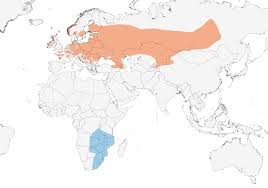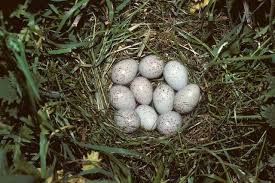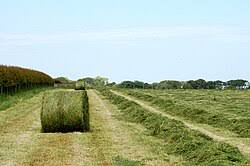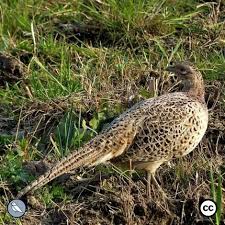The Disappearing Corn Crake

Corn Crake
Photo Image – The Guardian Newspaper
I don’t remember where I saw my first Corn Crake, but I recorded its sighting in my early 1960s bird log. It was likely seen or heard in a hayfield somewhere in Yorkshire, England. Its absence from my records during visits to Yorkshire’s Spurn Point bird observatory indicates that it was not a migrating bird travelling from Africa to Europe. Corn Crakes breed across Europe and Asia, arriving in April and May. They spend winter in parts of the Democratic Republic of the Congo and central Tanzania, south to eastern South Africa. “Corn” refers to the birds’ habitat, and “Crake” to its repetitive, grating call. In parts of Donegal, Ireland, where beans were once grown, people refer to the species as the “Bane” Crake.
 Corn Crake Range
Corn Crake Range
Photo Credit – Cornell Lab. of Ornithology. Blue is winter; orange is breeding
In 1958, a school in York provided the following statement about the Corn Crake.
“This species has shown the most dramatic change of any species in the York area…. At the end of the 19th century, it was a common bird right up to the suburbs of York…. The bird was so common that many boys did not bother to mention it in their diaries. The Corn Crake had almost disappeared from the East Riding by 1910, and from central and southern Yorkshire by 1920-24. It is still recorded in Yorkshire (but) as an uncommon summer migrant on passage.”
Corn Crakes are related to waterbirds such as Moorhens (Gallinules in North America), Coots, and Water Rails, but live on dry land. They are slightly larger than a blackbird, and their presence is usually identified by hearing the male’s distinctive rasping call during the breeding season of “crex crex”. The sound may be continuous at night. Corn Crake’s preferred habitat is in tall plant cover, such as hay and silage fields, meadows, and rough pastures. Consequently, you hear these birds more often than you see them. Corn Crakes are shy and secretive birds. As omnivores, they feed mainly on insects, snails, slugs, and worms, as well as some seeds.
This species is extremely rare in North America, occasionally appearing as a vagrant blown across the Atlantic during migration. It has been recorded less than a dozen times in the past 100 years. During the 1800s, it was a more frequent vagrant.
Corn Crakes are round-bodied and long-necked birds. Plumage is primarily yellowish-brown, with darker streaks on the back and blue-grey patches on the throat and underparts. The flanks are rust-colored with white bars; they are short-necked, have a stubby bill, and both sexes look alike. It is a short-lived species with a life expectancy of around 2 years, although some may survive 5 to 7 years. Because of their short life and the dangers during long migrations, only about 30 percent of breeding birds return the following year.
 Corn Crake Nest
Corn Crake Nest
Photo Credit – Cornell Lab. of Ornithology
They construct shallow nests on the ground, consisting of a scrape lined with dry grass and leaves, and concealed by tall vegetation. The female lays 8 to 12 eggs and may raise two broods each year. She alone incubates the eggs. The chicks leave the nest within 24 hours of hatching, but are only able to fly after 34 to 38 days. Outside the breeding season, Corn Crakes are solitary birds.
Today’s population of Corn Crakes in the UK and elsewhere in Western Europe is a shadow of its former self, and in some areas the bird is verging on extinction. Declines are associated with the reduction of hay meadows, shifts to short pasture, conversion of grassland to arable, earlier cutting of hay and silage, and multiple harvests each year. Agricultural schemes have been introduced in many European countries to protect Corn Crakes.
Changes in farming methods and the loss of grassland are the main reasons for the Corn Crake appearing on the UK Red List of most endangered birds. No longer are the hayfields reaped using a scythe. During my childhood, farmers were replacing horse-pulled hay cutters and hay rakes with tractors and balers. The most significant shift is the ensiling of fresh forage (silage) in place of haymaking, plus early cutting and multiple harvests each year.
 Silage
Silage
Photo Credit – Wikipedia
Silage is grass and other crops that are cut, fermented, and compressed until ready to be fed to livestock. Containing more moisture, silage retains a higher percentage of nutrients. The crop is compacted and stored in air-tight conditions without being dried, such as in large round bales wrapped in tight plastic that you may see littering some fields. It has largely replaced hay, which in 1970 accounted for 80 percent of the UK’s fodder.
Even so, the Corn Crake is not at risk of global extinction. Global monitoring has identified the existence of an estimated 3.6 million mature birds, with approximately 2.6 million residing in Europe, particularly Eastern Europe. At least one million are found in European Russia, and another half million in Asiatic Russia. The risk of extinction is greatest in Western Europe, including the United Kingdom, Ireland, Italy, Belgium, France, the Netherlands and Germany. In Luxembourg, the Corn Crake no longer breeds there and is only seen during its migration.
The UK reported 480 calling males in 1993, rising to 1,245 in 2014, and falling to 870 by 2023; however, it has returned to approximately 1,000. Since 1968, there has been a 75 percent reduction in the Corn Crake’s UK breeding range. Today, birds are confined to coastal areas and islands in northwest Scotland, the Orkneys, Shetland, and Rathlin Island in Northern Ireland.
There is also a small population in Norfolk, eastern England, where captive releases have reintroduced the species. Approximately 50 birds are released each year. However, very few survive the annual migrations.
Elsewhere in the UK, conservation efforts, such as “Corncrake Calling”, are underway. Its purpose is to introduce conservation management to Scottish farmers and crofters, help educate the public about the species and the effects of farming and influence rural development policies. Conservation actions include postponing mowing and grazing until late August, mowing from the center of a field outward (inside-out mowing) to allow birds and chicks to escape, increasing the acreage of tall grass, and leaving an uncut strip of grass along the edge of fields.
One last caution. If you want to identify a Corn Crake, you are unlikely to see one. It is much more likely that you will hear the male calling.
Finally, be careful not to confuse your sighting with a female pheasant or grey partridge.
 Female Common Pheasant
Female Common Pheasant
Photo Credit – Birdid.co.uk
 Grey Partridge
Grey Partridge
Photo Image – Game and Wildlife Conservation Trust
Finally, I acknowledge Saoirse Ronan and her film, The Outrun, for inspiring this article. Her attempts to seek refuge and recover from addiction as she diligently searches for the Corn Crake among the Orkney Islands are uplifting and gladdening.

The Outrun
Photo Image – IMDb



